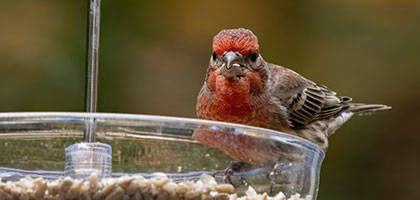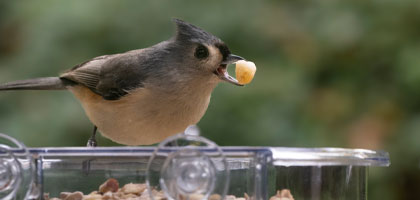Feeding finches can be a rewarding hobby. It brings color and life to your backyard.
But what do these small, vibrant birds prefer to eat? The answer lies in the seeds of thistle and nyjer plants.
Thistle and nyjer seeds are popular choices for attracting finches. Yet, many bird enthusiasts are unsure about which seed finches prefer.
Nyjer seed, often mistaken for thistle, is a small, black seed from the African yellow daisy. It's loved by finches for its high fat content and easy-to-eat size.
In this guide, we'll delve into the preferences of finches. We'll explore the benefits and drawbacks of each seed type.
Our aim is to help you make informed decisions about feeding finches. Let's create a bird-friendly environment that these delightful creatures will love.
Understanding Finch Preferences: Thistle vs. Nyjer Seed
Finches are fascinating birds with specific dietary preferences. They often gravitate toward seeds due to their nutritional content. However, not all seeds are equally favored by these charming birds.
Nyjer seed, commonly known as thistle, is particularly popular among finches. Despite its name, it is not true thistle but comes from an entirely different plant family. Thistle seeds are less commonly used but still attract some bird species.
The small, dark nyjer seed attracts many finches, especially American Goldfinches. It offers high nutritional benefits, making it a preferred choice. Nyjer seed is:
- High in fat content.
- Small and easily consumable.
- Less likely to germinate due to heat treatment.
On the other hand, thistle seeds do attract a variety of finch species too. They invite goldfinches, house finches, and even purple finches. Understanding these seeds helps in making a better feeding choice for your local bird population.
What Are Thistle and Nyjer Seeds?
Nyjer seed originates from the African yellow daisy, Guizotia abyssinica. It's commonly misnamed as thistle seed but is distinct. This seed is a small, black treasure trove of fats and proteins favored by finches.
True thistle seeds derive from plants in the thistle family. These seeds are less common in bird feeding circles. Thistle seeds might not be favored for their rarity but still play a role in attracting certain finch species.
Why Finches Love Nyjer Seed
Finches, especially the American Goldfinch, show a marked preference for nyjer seed. This tiny seed is rich in fats, offering significant energy. Finches need such nutrients for their active lifestyle and vibrant plumage.
Nyjer seeds are easy for finches to consume. Their small size fits perfectly into the finch's beak. Additionally, the seeds don’t create much waste, helping maintain a clean feeding area.
The high-fat content is a major draw for finches. It provides the energy they require daily, especially during migration or harsh weather. When seeking to attract finches, nyjer seed is undoubtedly an optimal choice.
The Lesser-Known Thistle Seed
Thistle seeds often take a back seat but still attract certain finch species. These seeds can invite goldfinches, house finches, and purple finches to your yard. Their oil-rich content gives them nutritional appeal, similar to nyjer seeds.
Though not as common as nyjer seeds in bird feeders, thistle seeds have their unique charm. They form part of a varied diet that many finch species enjoy. Offering different types of seeds can entice a broader range of birds to your feeders.
While lesser-known, thistle seeds still have merit in bird feeding. Including them alongside nyjer seeds ensures a richer feeding experience for finches. This seed variety can enhance your bird-watching endeavors significantly.
The Benefits of Nyjer Seed for Finches
Nyjer seed holds numerous advantages for both finches and bird watchers. It's a go-to choice for anyone wishing to attract these cheerful birds. Among its many benefits, the seed is prized for its nutritional content and suitability for finch-friendly feeding.
High Nutritional Value
Nyjer seed is highly valued for its rich nutritional profile. Its high fat content provides finches with essential energy, especially during cold months and migration. Besides fat, nyjer also offers ample protein and fiber, essential for finch health.
Finches thrive on this energy-rich diet. The seed's nutrition supports vibrant feathers and healthy growth. By offering nyjer seed, bird enthusiasts ensure finches receive a well-balanced meal, enhancing their vitality and beauty.
Minimizing Waste and Unwanted Guests
Nyjer seed is efficient with minimal waste. Its small size reduces spillage, keeping feeding areas clean and inviting for finches. The seed's hulls are thin and don’t create much debris, maintaining a tidy feeder space.
Another key benefit is nyjer's deterrent against unwanted guests. Squirrels and larger birds are less interested in the tiny seeds. This exclusivity allows finches to feed peacefully, attracting more of these delightful birds to your garden.
How to Properly Feed Finches with Nyjer and Thistle Seeds
Feeding finches effectively involves more than just providing seeds. Ensuring a welcoming and hygienic environment can attract more finches and keep them healthy. Follow these tips to optimize feeding with nyjer and thistle seeds.
- Select feeders with small openings to prevent seed spillage.
- Regularly inspect feeders for clogs and obstructions.
- Empty old seeds frequently to keep the feeder appealing.
- Choose feeders with a weather guard to protect seeds from rain.
- Place feeders in shaded areas to maintain seed quality.
Choosing the Right Feeder
Selecting the appropriate feeder enhances finches’ feeding experience. Opt for tube feeders designed specifically for nyjer seed, as they have small holes that match the seed size. This design minimizes waste and allows finches to feed comfortably and efficiently.
Choose a feeder with multiple perches to attract more birds simultaneously. Some feeders even have mesh sides, permitting easy clinging for finches. Proper feeder choice enables an enjoyable feeding environment tailored to finches' needs.
Maintaining Freshness and Cleanliness
Preserving seed freshness is essential to attracting and maintaining finch visits. Regularly refill feeders with fresh seeds, as old or damp seeds can clump and deter birds. Fresh nyjer and thistle seeds are more appealing, ensuring consistent finch traffic.
Clean feeders frequently to prevent mold and disease. A simple wash with mild soap and water keeps the feeding area sanitary. By maintaining cleanliness, feeders remain inviting and safe, supporting finch health and encouraging repeat visits.
Attracting Finches: Tips and Tricks
Drawing finches to your yard can be rewarding and delightful. By creating an ideal environment, you'll encourage more finch visits. Here are some tips and tricks to enhance your bird feeding setup:
- Provide fresh water sources near feeders.
- Incorporate native plants that produce seeds and berries.
- Avoid loud noises that might disturb birds.
- Offer a variety of seeds to attract different finch species.
Placement of Feeders
The placement of feeders plays a vital role in attracting finches. Position feeders in quiet, sheltered areas away from harsh weather conditions, which provides a safe and relaxed feeding spot. Elevate feeders to minimize disturbances from ground-level predators and create an inviting perch for finches.
Ensure the feeders are visible and accessible. Finches are more likely to approach feeders that can be easily spotted from the sky. Optimal placement not only attracts more finches but also ensures a longer stay during each visit.
Creating a Finch-Friendly Habitat
Designing a finch-friendly habitat involves more than just feeders. Plant native shrubs and trees that offer natural food and shelter. Such plants provide valuable perching and nesting options, making the area more attractive to finches.
Include a birdbath or water feature nearby to meet their hydration needs. Clean, accessible water is as crucial to finches as food. A comprehensive and well-planned habitat can transform your yard into a finch haven.
The Impact of Season and Environment on Finch Feeding Habits
Seasonal changes greatly affect finch feeding habits. During breeding season, finches require higher energy, often choosing seeds rich in oils, like nyjer seed. Seasonal food scarcity can also shift their preference towards feeders instead of foraging in the wild.
Environmental factors, such as weather and natural food availability, influence finch behavior. For example, harsh winters often drive finches toward reliable feeder sources. In regions where natural seeds are abundant, finches might not rely as heavily on feeder seeds.
Understanding these patterns can enhance your bird feeding strategy. By observing seasonal and environmental factors, you can adjust seed offerings to align with finch preferences. This ensures a more welcoming and supportive feeding environment throughout the year.
Ethical Bird Feeding and Conservation Efforts
Ethical bird feeding is essential for the well-being of finches and the health of ecosystems. It's crucial to support finch populations while preserving natural habitats. Responsible feeding practices can promote conservation and awareness.
Here are some guidelines for ethical feeding practices:
- Ensure feeders are clean and free from mold or pests.
- Use seed from sustainable sources to minimize harm to ecosystems.
- Avoid feeding birds harmful foods like bread or spoiled seeds.
Encourage a sense of stewardship for nature through mindful bird feeding, enhancing local ecosystems and benefiting finches and other wildlife alike.
Supporting Local Ecosystems
Supporting local ecosystems through bird feeding involves using eco-friendly practices. This includes selecting seeds from sustainable agriculture to reduce ecological impact. Additionally, planting native flora in your yard can provide finches with natural food sources and shelter.
Participating in Citizen Science
Engagement in citizen science enhances our understanding of finch behaviors and populations. Contributing observations to projects like bird counts helps track population changes. Participation provides valuable data for researchers and fosters a deeper connection with nature.
Conclusion: Fostering a Love for Finches and Nature
Feeding finches is more than a hobby; it fosters a connection to nature. Providing high-quality food like nyjer seed supports these vibrant birds and enriches our environment.
By practicing ethical bird feeding, we contribute to ecological balance. Our efforts nurture a shared appreciation for finches and inspire further conservation actions.




